Here are Google’s new minimum RAM and storage requirements for Android phones

With Android 15, Google requires at least 32GB of storage for smartphones that want to have its suite of apps and services preinstalled (this is usually referred to as Google Mobile Services or GMS). Of those 32GB, at least 75% of the storage size has to be dedicated to the data partition, which stores preinstalled system apps, system app data, certain system files, and all user apps and files.
The previous limit was 16GB, enforced ever since Android 13, and before that it was 8GB. Note that a phone with less than 32GB of storage can’t even get updated to Android 15 if it launched on an earlier version.
Of course, there aren’t that many devices still out there with 16GB or 32GB of storage, thankfully, and needless to say, your experience using a phone with 32GB of storage will be dreadful, Android 15 or not. But it’s interesting to see that Google has an actual minimum storage size it’s enforcing for those devices that want GMS.
The same goes for RAM. Devices with 2GB and 3GB of RAM must use Android Go Edition, the version designed for ultra-low-end phones, while those with less than 2GB of RAM can’t get GMS at all. Phones with 4GB of RAM can still get GMS and run full Android 15, but starting on Android 16 they will also have to go the Android Go route, meaning there will in effect be a minimum RAM requirement of 6GB for running full Android.
Google is also requiring devices on Android 15 to give users the option to share their emergency contacts data with the system’s Emergency Location Service during emergency calls. This is the feature that lets you opt in to share your emergency contacts along with your location data when contacting emergency services. Thus it lets emergency services reach out to your emergency contacts, and of course it allows them to easily locate you when you are in an emergency.
To protect your privacy, Google mandates a clear disclosure about what information may be shared with emergency services. The company also makes it clear that emergency contact data sharing has to be opt-in.
Source
Source link







